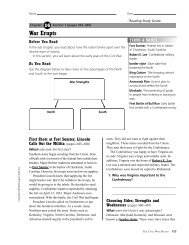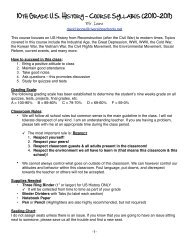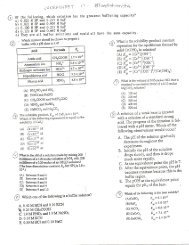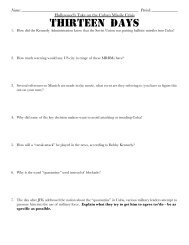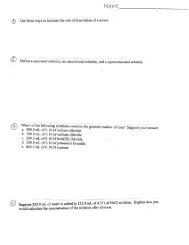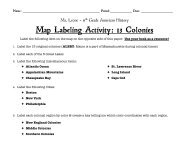Chapter 16 Text
Chapter 16 Text
Chapter 16 Text
Create successful ePaper yourself
Turn your PDF publications into a flip-book with our unique Google optimized e-Paper software.
Exercises 655<br />
<strong>16</strong>.28 Complete the following table by calculating the missing<br />
entries. In each case indicate whether the solution is acidic<br />
or basic.<br />
pH<br />
6.21<br />
pOH<br />
10.13<br />
[H+]<br />
3.5 X 10~3 M<br />
[OH']<br />
5.6 X 10~4 M<br />
acidic<br />
or basic?<br />
<strong>16</strong>.29 The average pH of normal arterial blood is 7.40. At normal<br />
body temperature (37°C), Kw = 2.4 x 10"14. Calculate<br />
[H+] and [OH~] for blood at this temperature.<br />
<strong>16</strong>.30 Carbon dioxide in the atmosphere dissolves in raindrops<br />
to produce carbonic acid (H2CO3), causing the pH of<br />
clean, unpolluted rain to range from about 5.2 to 5.6.<br />
What are the ranges of [H+] and [OH~] in the raindrops?<br />
Strong Acids and Bases<br />
<strong>16</strong>.31 (a) What is a strong acid? (b) A solution is labeled 0.500 M<br />
HC1. What is [H+] for the solution? (c) Which of the following<br />
are strong acids: HF, HC1, HBr, HI?<br />
<strong>16</strong>.32 (a) What is a strong base? (b) A solution is labeled<br />
0.125 M Sr(OH)2. What is [OH~] for the solution? (c) Is<br />
the following statement true or false? Because Mg(OH)2<br />
is not very soluble, it cannot be a strong base. Explain.<br />
<strong>16</strong>.33 Calculate the pH of each of the following strong acid solutions:<br />
(a) 8.5 X 10~3MHBr; (b) 1.52 g of HNO3 in<br />
575 mL of solution; (c) 5.00 mL of 0.250 M HC1O4 diluted<br />
to 50.0 mL; (d) a solution formed by mixing 10.0 mL<br />
of 0.100 M HBr with 20.0 mL of 0.200 M HCL<br />
<strong>16</strong>.34 Calculate the pH of each of the following strong acid solutions:<br />
(a) 0.0575 M HNO3; (b) 0.723 g of HC1O4 in 2.00 L<br />
of solution; (c) 5.00 mL of 1.00 M HC1 diluted to 0.750 L;<br />
(d) a mixture formed by adding 50.0 mL of 0.020 M HC1<br />
to 125 mL of 0.010 M HI.<br />
<strong>16</strong>.35 Calculate [OH'] and pH for (a) 1.5 x 10~3 M Sr(OH)2;<br />
(b) 2.250 g of LiOH in 250.0 mL of solution; (c) 1.00 mL<br />
of 0.175 M NaOH diluted to 2.00 L; (d) a solution<br />
formed by adding 5.00 mL of 0.105 M KOH to 15.0 mL<br />
of 9.5 X 10~2MCa(OH)2.<br />
<strong>16</strong>.36 Calculate [OH""] and pH for each of the following strong<br />
base solutions: (a) 0.0050 M KOH; (b) 2.055 g of KOH in<br />
500.0 mL of solution; (c) 10.0 mL of 0.250 M Ca(OH)2<br />
diluted to 500.0 mL; (d) a solution formed by mixing<br />
10.0 mL of 0.015 M Ba(OH)2 with 30.0 mL of<br />
7.5 X 1Q-3 M NaOH.<br />
<strong>16</strong>.37 Calculate the concentration of an aqueous solution of<br />
NaOH that has a pH of 11.50.<br />
<strong>16</strong>.38 Calculate the concentration of an aqueous solution of<br />
Ca(OH)2 that has a pH of 12.00.<br />
[<strong>16</strong>.39] Calculate the pH of a solution made by adding 15.00 g of<br />
sodium hydride (NaH) to enough water to make 2.500 L<br />
of solution.<br />
[<strong>16</strong>.40] Calculate the pH of a solution made by adding 2.50 g of<br />
lithium oxide (Li2O) to enough water to make 1.200 L of<br />
solution.<br />
Weak Acids<br />
<strong>16</strong>.41 Write the chemical equation and the Ka expression for<br />
the ionization of each of the following acids in aqueous<br />
solution. First show the reaction with H+(aq) as a product<br />
and then with the hydronium ion: (a) HBrO2;<br />
(b)HC3H502.<br />
<strong>16</strong>.42 Write the chemical equation and the Ka expression for the<br />
acid dissociation of each of the following acids in aqueous<br />
solution. First show the reaction with H+(aq) as a<br />
product and then with the hydronium ion: (a) HQH5O;<br />
(b) HC03~.<br />
<strong>16</strong>.43 Lactic acid (HC3H5O3) has one acidic hydrogen. A 0.10 M<br />
solution of lactic acid has a pH of 2.44. Calculate Ka.<br />
<strong>16</strong>.44 Phenylacetic acid (HC8H7O2) is one of the substances<br />
that accumulates in the blood of people with phenylketonuria,<br />
an inherited disorder that can cause mental<br />
retardation or even death. A 0.085 M solution of<br />
HC8H7O2 is found to have a pH of 2.68. Calculate the<br />
Ka value for this acid.<br />
<strong>16</strong>.45 A 0.200 M solution of a weak acid HA is 9.4% ionized.<br />
Using this information, calculate [H+], [A~], [HA], and Ka<br />
for HA.<br />
<strong>16</strong>.46 A 0.100 M solution of chloroacetic acid (C1CH2COOH)<br />
is 11.0% ionized. Using this information, calculate<br />
[ClCH2COCn, [H+], [C1CH2COOH], and Ka for<br />
chloroacetic acid.<br />
<strong>16</strong>.47 A particular sample of vinegar has a pH of 2.90. Assuming<br />
that acetic acid is the only acid that vinegar contains<br />
(Ktt = 1.8 X 10^5), calculate the concentration of acetic<br />
acid in the vinegar.<br />
<strong>16</strong>.48 How many moles of HP (Ka = 6.8 X 10~4) must be present<br />
in 0.500 L to form a solution with a pH of 2.70?<br />
<strong>16</strong>.49 The acid-dissociation constant for benzole acid (HC7HsO2)<br />
is 6.3 X 10~5, Calculate the equilibrium concentrations of<br />
H3O+, C7H5O2~, and HC7H5O2 in the solution if the initial<br />
concentration of HC7H5O2 is 0.050 M.<br />
<strong>16</strong>.50 The acid-dissociation constant for hypochlorous acid<br />
(HC1O) is 3.0 X 1CT8. Calculate the concentrations of<br />
H3O+, C1O~, and HC1O at equilibrium if the initial concentration<br />
of HC1O is 0.0075 M.<br />
<strong>16</strong>.51 Calculate the pH of each of the following solutions (Ka<br />
and Kb values are given in Appendix D): (a) 0.095 M propionic<br />
acid (HC3H5O2); (b) 0.100 M hydrogen chrornate<br />
ion (HCrO4~);



